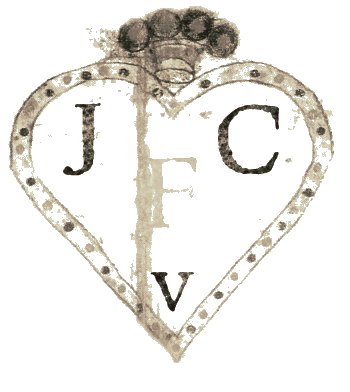History
Tradition has it that the Virgin Mary appeared to San Magno (Saint Magnus) Bishop
of Oderzo, in the form of a buxom (formosa
in Italian) woman and told him to build her a church under a white
cloud. And so this, the first church in Venice dedicated to the
Virgin Mary, was built, some time in the 7th century by the Tribuno
family. The first certain documentation concerns rebuilding in 1060,
and there were one or two more rebuildings before the current
church was built by
Mauro Codussi, with work commencing on the 1st of June 1492. He kept to the dimensions of the foundations of the
earlier church which was by then almost in ruins.
The church was visited by the doge and a procession of twelve young
girls every 2nd of February - the Feast of the Purification of the
Virgin, or Candlemass. This procession of 'Marias' was to
commemorate the rescue of the brides abducted by pirates from Istria
and Trieste from San Pietro di Castello some time in 944. Santa
Maria Formosa being the centre for the guild of casselleri (casemakers)
who carried out the rescue and requested an annual visit from the
doge as reward. This was also the church of the scuole of
fruit-sellers and gunners.
The church
The current church was planned by Codussi but the exterior was
completed after his death in 1504 by unknown hands. The cupola was
probably added by Codussi's son Domenico, following his father's design. The fašade onto
the rio was erected in 1542 and commemorates Vincenzo Cappello, a
sea captain who was victorious against the Turks. The fašade onto the campo (maybe
by Smeraldi) was completed in 1604 and contains portraits of other
members of the Cappello family. These fašades were paid for by,
well, the Cappello family. They were restored by Venice in Peril in
the mid-1990s. The interior was
renovated by merchant Torrino Tononi
in 1689. The
dome was repaired in 1688 after an earthquake that year, and in 1921 following
a hit during Austrian bombing in 1916.
The interior
Codussi's
centralised
interior kept the existing Greek cross plan. As you enter it's
initially a confusing and asymmetrical-seeming space, the nave is a bit longer than the apse,
so the church can be, and has been, described as a fusion of the Latin
cross and the Greek cross. The first chapel on the
right has the highlight Vivarini, the highlight Palma is the far right
chapel in the crossing. There's a free standing arched high altar with an
altarpiece on the curved wall behind by Giovanni Segala depicting The
Presentation to the Doge of the Brides Kidnapped by Narentine Pirates.
Art highlights
One enters through the main door now, and behind the Chorus desk there's
the small tondo of The Circumsision of Christ by Catena, a Venetian artist
we're always happy to see something by, his works being rare, although this one is labelled attrib. This is quickly
followed by a highlight triptych by Bartolomeo Vivarini (see
below right). The central
panel of the Madonna della Misericordia is flanked on the
left by a painting of her parents, Anne and Joachim, who are about to
embrace and kiss, this being how she was conceived. This triptych
has lost its original gilded Gothic frame, and seems a bit small the later
marble frame it now inhabits.
Then there's the
Santa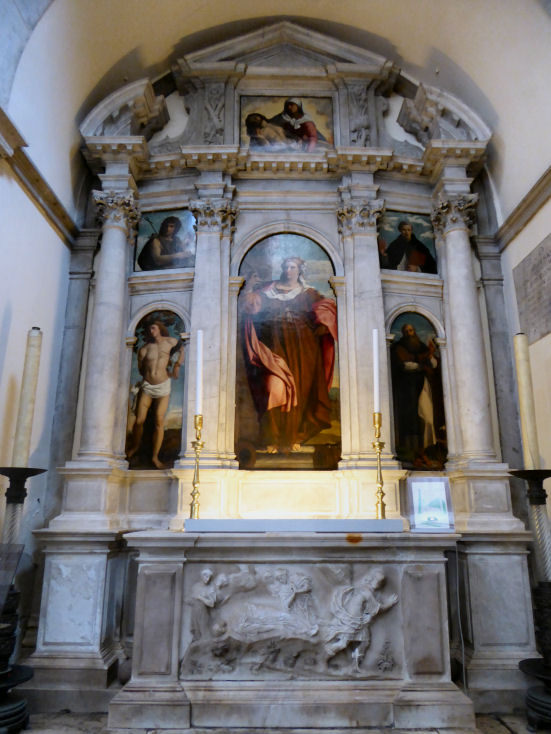 Barbara
Altarpiece by Palma Vecchio (see right) , and a fine and forceful looking woman he
makes her too, in this his Giorgione-inspired masterpiece of
c.1522/24.
(She is said to be a portrait of his daughter Violante,
beloved of Titian, but Palma never seems to have been married.) She stands
on a pedestal between cannon and there's a tower, her attribute, in the
background. She is flanked by smaller panels of Saints Sebastian and
Anthony Abbot and they are topped by smaller half-lengths of Saints
John the Baptist and Vincent Ferrer. There's a PietÓ in the pediment.
Anthony Abbot and Vincent Ferrer carry flames, not their usual attributes.
The cannon and flames are there because this is the altar dedicated to the
Scuola di Bombardieri (artillerymen) whose patron saint
Barbara is.
This scuola played a prominent part in public processions, not
because of its influence or relics, but because of its spectacular
uniforms. Vasari thought
her one of Palma's best works. It is claimed to
be the last great
polyptych commissioned for a Venetian church, as the
form was by then falling out of fashion. The marble
framing is 18th century. On the altar below is a carved relief showing her
lying on the ground with her head unattached, because she's just been
decapitated by her father. Barbara
Altarpiece by Palma Vecchio (see right) , and a fine and forceful looking woman he
makes her too, in this his Giorgione-inspired masterpiece of
c.1522/24.
(She is said to be a portrait of his daughter Violante,
beloved of Titian, but Palma never seems to have been married.) She stands
on a pedestal between cannon and there's a tower, her attribute, in the
background. She is flanked by smaller panels of Saints Sebastian and
Anthony Abbot and they are topped by smaller half-lengths of Saints
John the Baptist and Vincent Ferrer. There's a PietÓ in the pediment.
Anthony Abbot and Vincent Ferrer carry flames, not their usual attributes.
The cannon and flames are there because this is the altar dedicated to the
Scuola di Bombardieri (artillerymen) whose patron saint
Barbara is.
This scuola played a prominent part in public processions, not
because of its influence or relics, but because of its spectacular
uniforms. Vasari thought
her one of Palma's best works. It is claimed to
be the last great
polyptych commissioned for a Venetian church, as the
form was by then falling out of fashion. The marble
framing is 18th century. On the altar below is a carved relief showing her
lying on the ground with her head unattached, because she's just been
decapitated by her father.
Campanile 40m (130ft) electromechanical bells
De Barbari's map shows a squat brick tower with a sugar-loaf spire
surrounded by four pinnacles. This was replaced with the current
campanile, designed by Francesco Zucconi, a priest, in 1678-88. On the arch at the base of the
campanile is a grotesque mascherone - a carved head said to
dispel evil spirits (see below right) - which was much loathed by a
somewhat squeamish Ruskin. Leering in bestial degradation he
said, too foul to be either pictured or described, or to be
beheld for more than an instant. He
then, in prose somewhat spittle-flecked even for him, goes on to
claim that these faces, characteristic of the later years of the
Republic, symbolised the evil spirit that lead to Venice's final
decline. It seems odd to me that a man who repeatedly argues the supremacy of
the 'authentic' gothic over the 'debased' renaissance style should
be so set against such grotesques. He then argues that
there's a difference between true and false grotesque. Oh, and he prudishly
translated the word formosa as
beautiful.
Also the carved head is said to actually represent
someone suffering from fibromatosis or von Recklinghausen's disease.
The church in art
The Campo Santa Maria Formosa by Canaletto in 1733-4 is in
the Woburn collection.
Reproduced by Bellotto around 1742. There's also an oil painting by Sickert
in a private collection
and an etching by one D.S. MacLaughlan (see far right).
The church in fiction
Santa Maria Formosa plays an important, if not picturesquely
evoked,
part in Muriel Spark's novel Territorial Rights. The
adjective frequently used in the book to describe the church is
'bulbous'.
Opening times
Monday to Saturday: 10.30 - 1.30 and 2.30
- 5.00
Sundays: closed
A Chorus
Church
Vaporetto Rialto or San Zaccaria
map
|
|

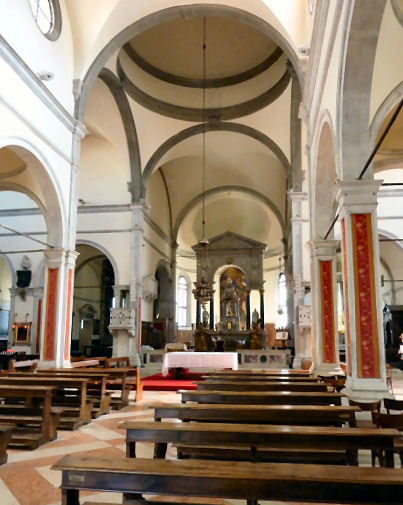

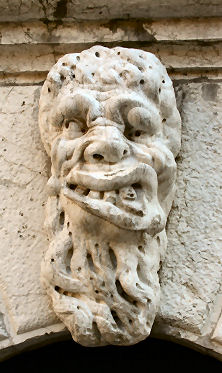
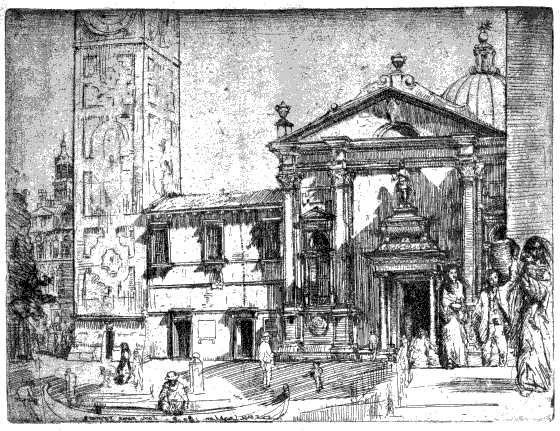
|

